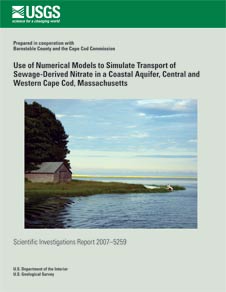Scientific Investigations Report 2007–5259

By Donald A. Walter
This report is available as a printed product and in PDF Format (3,973 MB)
The cover for this report is also available in PDF Format (276 KB)
The unconsolidated glacial sediments underlying Cape Cod, Massachusetts compose a regional aquifer system that is used both as a source of drinking water and as a disposal site for wastewater; in addition, the discharge of clean ground water from the aquifer system is needed for the maintenance of freshwater and marine ecosystems throughout the region. Because these uses of the aquifer conflict with one another in many areas of the Cape, local and regional planners have begun to develop sustainable wastewater plans that will facilitate the disposal of wastewater while protecting water supplies and improving the health of aquatic ecosystems. To assist local and regional planners in these efforts, the U.S. Geological Survey conducted a 2-year investigation to (1) assist local and regional planners in the evaluation of potential wastewater scenarios, (2) use results and interpretation from these analyses to develop hydrologic concepts transferable throughout the region, and (3) establish and test methods that would be of use in future evaluations.
Wastewater-disposal scenarios need to be evaluated in the context of the regional ground-water-flow system. For a given rate of disposal, wastewater from sites at or near a regional ground-water divide is transported in a wider arc of flow directions, flows deeper in the system, and contaminates a larger part of the aquifer than does wastewater discharged from sites farther from the divide. Also, traveltimes of wastewater from sites near a ground-water divide to receptors are longer (as much as several hundred years) than traveltimes from sites farther from the divide. Thus, wastewater disposal at or near a divide will affect a larger part of the aquifer and likely contribute wastewater to more receptors than wastewater disposal farther from a divide; however, longer traveltimes could allow for more attenuation of wastewater-derived nitrate from those sites.
Ground-water-flow models and particle tracking can be used to identify advective-transport patterns downgradient from wastewater-disposal sites and estimate traveltimes; however, these tools cannot predict the distribution of mass or concentrations of wastewater constituents, such as nitrate, in the aquifer. Flow-based particle-tracking analyses can be used to estimate mass-loading rates and time-varying concentrations at wells and ecological receptors by the accounting of mass-weighted particles discharging into the receptor of interest. This method requires no additional development beyond the flow model; however, post-modeling analyses are required. In addition, the method is based on the assumption that no mass is lost during transport, an assumption that likely is not valid in many systems. Solute-transport models simulate the subsurface transport of nitrate through the aquifer and predict the distribution of the mass of a solute in the aquifer at different transport times. This method does require additional model development beyond the flow model, but can predict timevarying concentrations at receptors. Estimates of mass-loading rates require minimal post-modeling analyses.
Time-varying concentrations and mass-loading rates calculated for wells in eastern Barnstable by the two methods generally were in reasonable agreement. Inherent in the flow-based particle-tracking method is the assumption that mass is conserved along a given flow line and that there is no spreading of mass in the aquifer. Although the solute-transport models also incorporate a system-wide conservation of mass, these models allow for a spreading of mass in the aquifer, and mass is not conserved along a given flow line. As a result, estimates of concentrations and mass loading rates generally were higher in particle-tracking analyses than in solute-transport simulations. Results from the two types of simulations agreed best for wells that receive large amounts of wastewater with short traveltimes (less than 10 years) because insufficient transport time likely had elapsed to make the assumption of conservation of mass along flow lines problematic. The results agreed less closely for wells that receive wastewater with long traveltimes because dispersion may have attenuated simulated concentrations. In these cases, the conservation of mass was a more problematic assumption. Given particle densities that are practicable, particle-tracking simulations may not represent advective transport in divergent flow fields with enough resolution to adequately estimate time-varying concentrations and mass-loading rates in those areas. Also, particle tracking is more likely to overpredict mass-loading rates for wells in areas where dispersion may be important, such as near the edge of a wastewater plume, at large transport distances from a source, or downgradient from a pond.
Abstract
Introduction
Purpose and Scope
Methods of Analysis
Hydrogeology
Geologic Setting
Hydrologic Setting
Nitrogen Transport in Ground Water
Numerical Models
Regional Models
Regional Model Design
Modifications to the Regional Models
Subregional Model
Model Design
Model Stresses
Solute Transport
Simulation of Nitrate Transport
Advective Transport and Discharge to Wells and Ecological Receptors
Discharge to Wells and Ecological Receptors
Advective Transport in Different Hydrologic Settings
Solute-Transport Simulations
Comparison to Advective-Transport Simulations
Effects of Dispersion
Limitations of Analysis
Summary
References Cited
Suggested citation:
Walter, D.A., 2008, Use of Numerical Models to Simulate Transport of Sewage-Derived Nitrate in a Coastal Aquifer, Central and Western Cape Cod, Massachusetts: U.S. Geological Survey Scientific Investigations Report 2007–5259, 41 p.
If you have Adobe® Acrobat® or Adobe® Acrobat® Reader® installed on your computer, you may view and print the PDF version of this report. Acrobat Reader, is a free download from Adobe Systems, Inc. Users with disabilities can view information concerning accessibility at access.Adobe.com.
For more information about USGS activities in Massachusetts contact,
dc_ma@usgs.gov
U.S. Geological Survey
Massachusetts-Rhode Island Water Science Center
10 Bearfoot Road, Northborough, MA 01532
or visit our Web site at
http://ma.water.usgs.gov